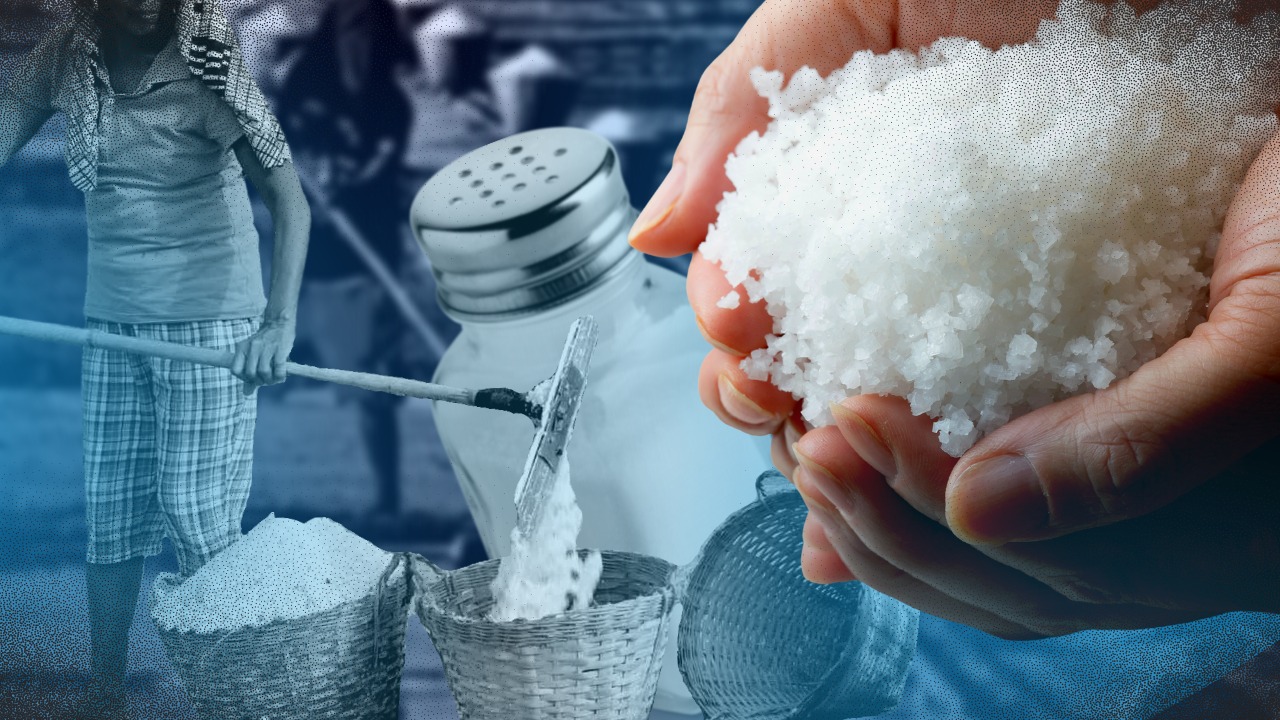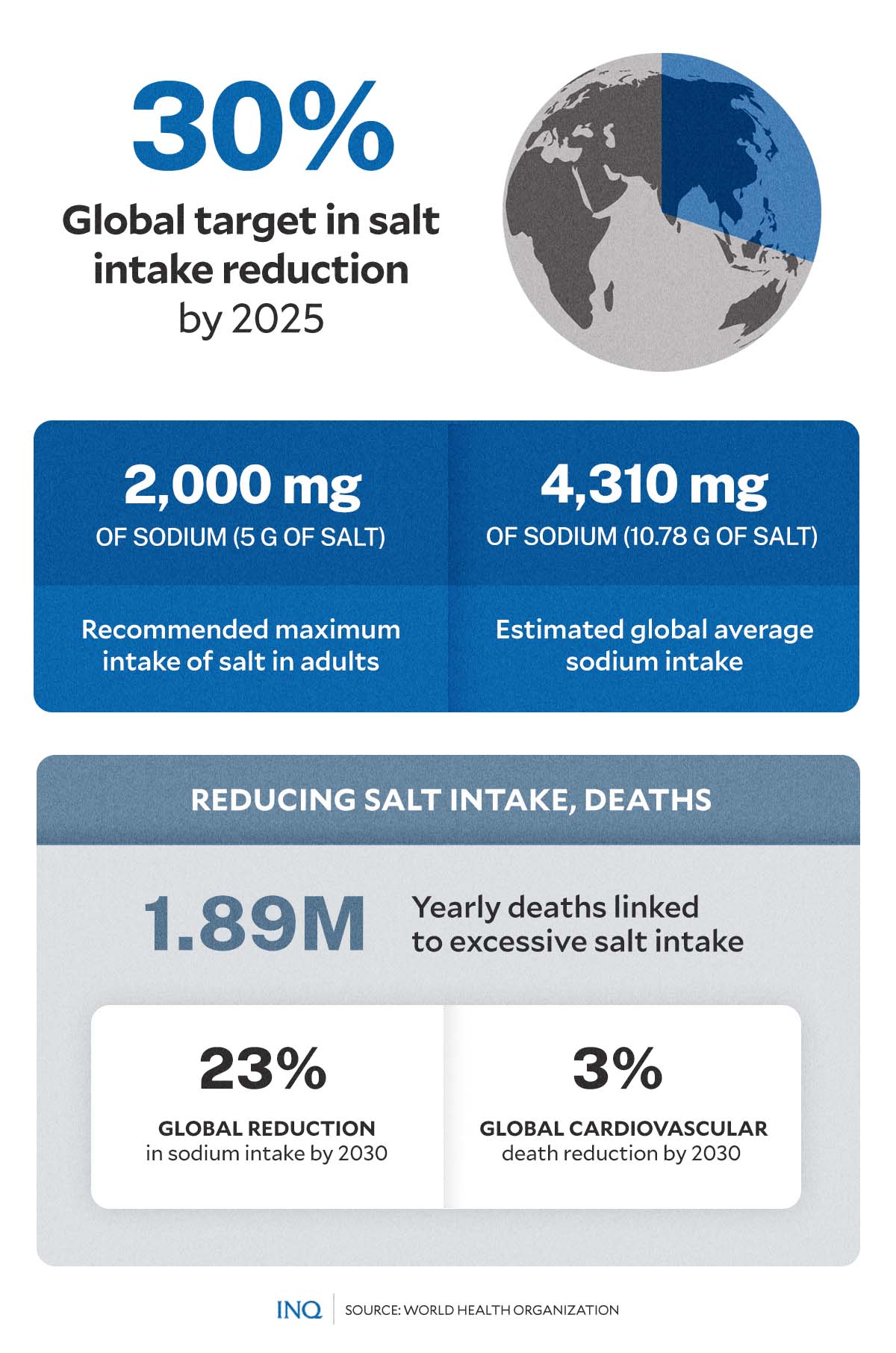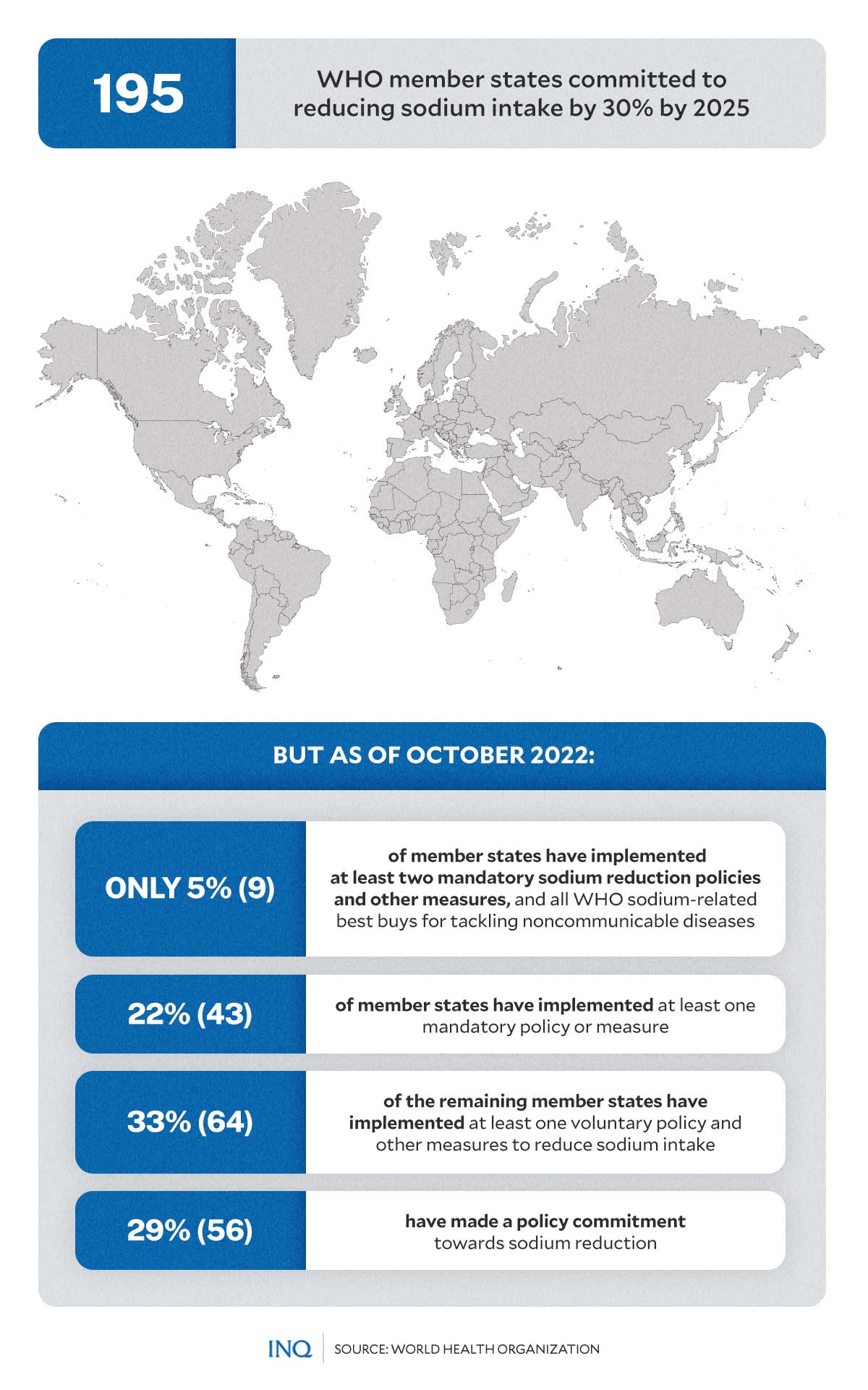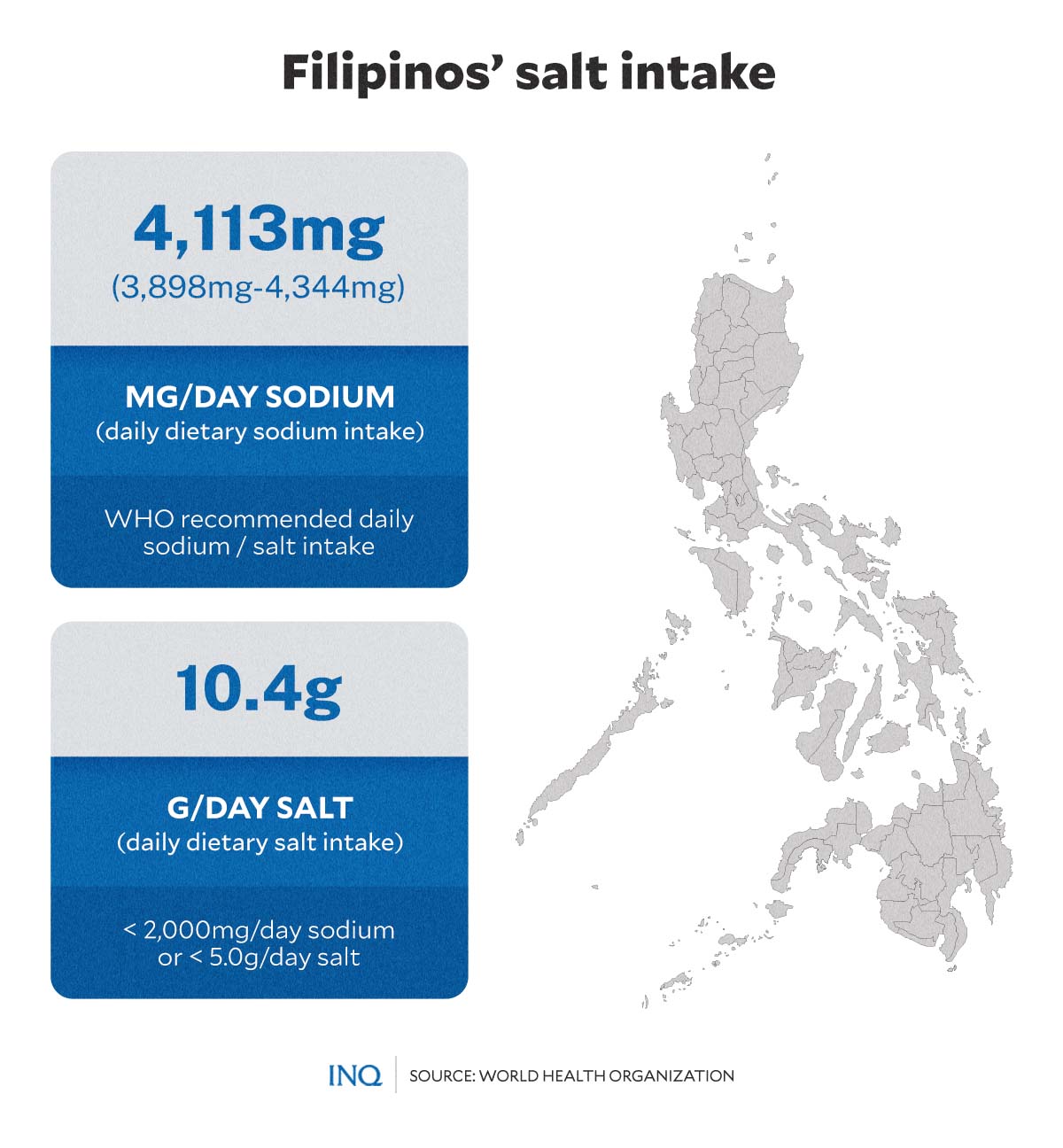WHO study bares bitter health impact of excessive salt use: Deaths, diseases

COMPOSITE IMAGE BY JEROME CRISTOBAL FROM INQUIRER STOCK AND FILE PHOTOS
MANILA, Philippines—Countries worldwide are off-track in achieving the global target of reducing sodium intake by 30 percent by 2025, the World Health Organization (WHO) revealed in a first-of-its-kind report on global sodium intake reduction.
According to the US Centers for Disease Control and Prevention (CDC), the body requires a small amount of sodium to function. The sodium that people consume usually comes from table salt (sodium chloride) or those that are in other condiments, such as sodium glutamate.
However, WHO stressed that excess sodium intake increases the risk of high blood pressure, heart disease, stroke, and premature death. Data showed that an estimated 1.89 million deaths each year are associated with excessive intake of sodium.
READ: More than calories, count sodium content of processed food
In 2013, WHO member states committed to reducing sodium intake by the year 2025.
“Reducing sodium intake is one of the most cost-effective ways to improve health and reduce the burden of non-communicable diseases, as it can avert a large number of cardiovascular events and deaths at very low total program costs,” WHO said.
Article continues after this advertisementImplementing highly cost-effective sodium reduction policies could save an estimated 7 million lives globally by 2030. Policy implementation can reduce global sodium intake by 23 percent and cardiovascular death by 3 percent.
Article continues after this advertisementHowever, WHO’s first-ever documented progress on global policy adoption to achieve the global sodium intake reduction target found that “progress has been slow.”

GRAPHIC Ed Lustan
“[O]nly a few countries have been able to reduce population sodium intake, but no one has been able to achieve the target. As such, it is being considered to extend the target to 2030,” said Dr. Francesco Branca, director of the Department of Nutrition for Health and Development at WHO in Geneva.
Global excess sodium intake
WHO recommended a maximum intake of less than 2,000 mg of sodium per day—or less than 5g of salt daily—in adults. The recommended maximum sodium intake in adults should be adjusted downward based on the energy requirements of children relative to those of adults.
However, the report said that the global average sodium intake is estimated to be 4,310 mg per day—around 10.78 g of salt daily—which WHO said “far exceeds the physiological requirement and is more than [the organization’s] recommendation.”
“Urgent action is required to modify the production and consumption of foods and beverages, including industry manufactured (pre-packaged) food,” WHO said.
“Of greatest concern is excess consumption of sodium, sugars, and unhealthy fats, particularly trans-fatty acids (trans fats) and saturated fatty acids, and low consumption of whole grains, pulses, vegetables, and fruits,” it added.
Aside from monitoring excessive sodium intake, WHO likewise monitored member states’ progress in making national commitments and taking a multifaceted approach to implementing policies to reduce sodium intake through the Sodium Country Score Card.
According to WHO, the score card depicts countries that:
- Score 1: have made national policies, strategies, or action plans that express a commitment to reduce sodium intake
- Score 2: have implemented voluntary measures that reduce sodium in the food supply or encourage consumers to make healthier food choices about sodium
- Score 3: have implemented mandatory measures to reduce sodium in the food supply or encourage consumers to make healthier food choices, including mandatory declaration of sodium on all pre-packaged food
- Score 4: have implemented multiple mandatory measures, mandatory declaration of sodium on all pre-packaged food, and all sodium-related WHO Best Buys
WHO’s monitoring uncovered that out of the 194 member states that committed to reducing population sodium intake, only 5 percent—nine countries and territories—are protected by mandatory and comprehensive sodium reduction policies.

GRAPHIC Ed Lustan
WHO said the remaining 73 percent—185 countries and territories—lack the full range of implementation of such policies.
“Eating too much salt makes it the top risk factor for diet and nutrition-related deaths. More evidence is emerging documenting links between high sodium intake and increased risk of other health conditions such as gastric cancer, obesity, osteoporosis, and kidney disease,” WHO warned.
PH implementation
WHO estimated that around 25.99 percent of the world’s population lives in countries with mandatory measures on sodium reduction and mandatory declaration of sodium, including the Philippines.
The Philippines’ sodium country score showed that the government had implemented at least two mandatory measures for sodium reduction.
One of these measures was the Food and Drug Administration’s (FDA) Administrative Order No. 2014-0030 or the “Revised Rules And Regulations Governing The Labeling of Prepackaged Food Products,” which requires the label of all prepackaged food to include minimum mandatory information, such as:
- a complete list of ingredients
- nutrition facts
The Department of Education (DepEd) also passed Department Order No. 13 in 2017—the “Policy and Guidelines on Healthy Food and Beverage Choices in Schools and in DepEd Offices”—which aim to make available healthier food and beverage choices among learners and DepEd employees and stakeholders, among others.
Filipinos’ high sodium intake
However, despite existing mandatory measures, the daily sodium intake of Filipinos remains higher than the WHO-recommended sodium intake.
According to WHO, as of October 2022, the country’s estimated daily dietary sodium intake is 4,113 mg or between 3,898 mg and 4,344 mg. This is an equivalent of 10.4 g of salt per day.
“Government strategies to reduce salt intake have focused primarily on influencing consumer behavior through dietary guidelines, nutrition labelling, and awareness campaigns,” WHO previously said.
“So far, there are no policies establishing maximum salt targets or providing salt warning labels on foods in the Philippines,” it added.
WHO urged the Philippine government to coordinate efforts to develop a policy and strategy to reduce population salt consumption—emphasizing that cardiovascular diseases (CVDs) remain the leading causes of mortality in the country.

GRAPHIC Ed Lustan
Around 35 percent of all deaths in the Philippines, the organization said, were due to CVDs—of which 53 percent are premature. Among the most important behavioral risk factors of CVDs is an unhealthy diet—consuming foods high in sugar, salt or sodium, and fat and containing industrially produced trans-fat.
READ: PH Heart Month: Heart disease death toll dwarfs COVID’s
The organization added that the prevalence of hypertension among Filipinos remains high, with about 20 percent of Filipino adults diagnosed with high blood pressure.
READ: Hypertension: What to know about the ‘silent killer’
How to reduce sodium intake?
“Unhealthy diets are a leading cause of death and disease globally, and excessive sodium intake is one of the main culprits,” said WHO Director-General Dr. Tedros Adhanom Ghebreyesus.
“[M]ost countries are yet to adopt any mandatory sodium reduction policies, leaving their people at risk of heart attack, stroke, and other health problems. WHO calls on all countries to implement the ‘Best Buys’ for sodium reduction, and on manufacturers to implement the WHO benchmarks for sodium content in food,” he added.
WHO’s Best Buy is a comprehensive approach to sodium reduction that includes adopting mandatory policies and interventions related to sodium—which greatly contribute to preventing non-communicable diseases.
These include:
- Reformulating foods to contain less salt, and setting targets for the amount of sodium in foods and meals.
- Establishing public food procurement policies to limit salt or sodium-rich foods in public institutions such as hospitals, schools, workplaces and nursing homes.
- Front-of-package labeling that helps consumers select products lower in sodium.
- Behavior change communication and mass media campaigns to reduce salt or sodium consumption.
“We can reduce sodium intake by deciding to add less salt to the food we prepare and by deciding to buy foods that contain less sodium. People’s behaviour change is important, and mass media campaigns to alter consumer behaviour around sodium are needed,” Dr. Branca said.